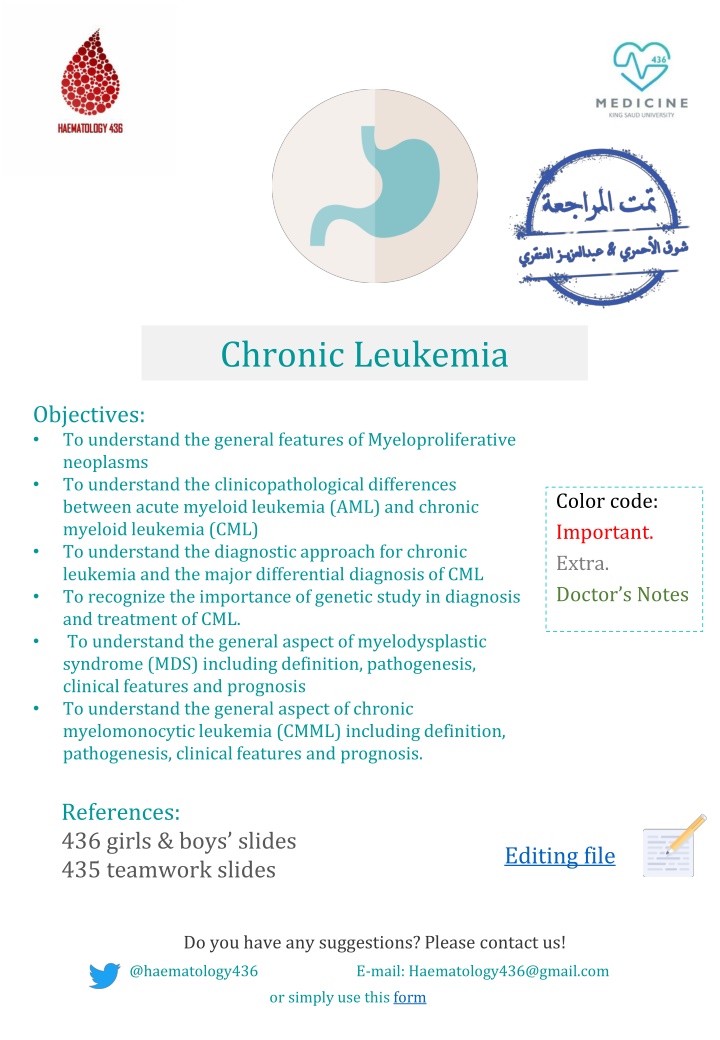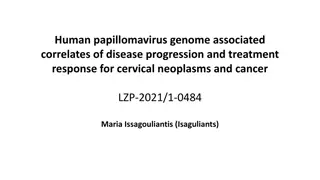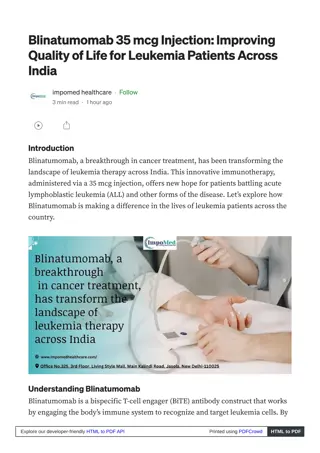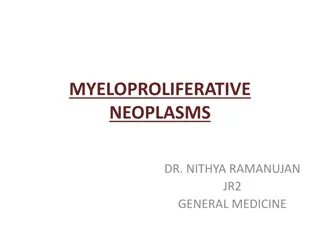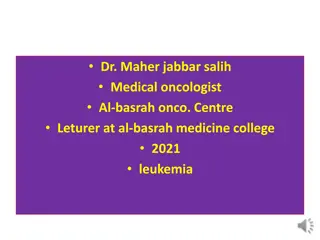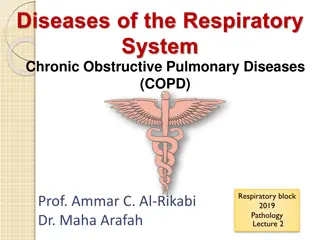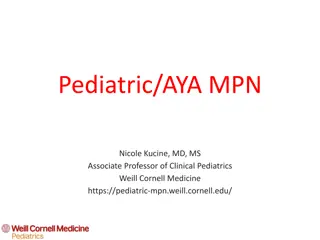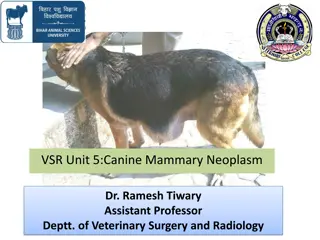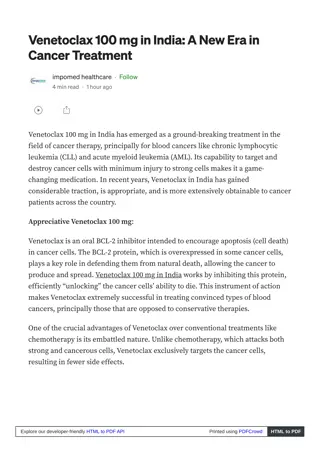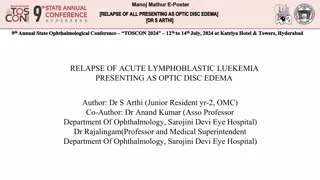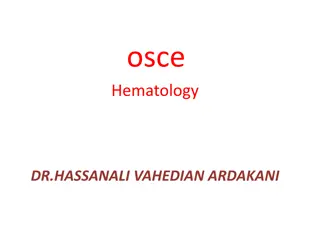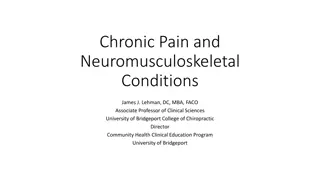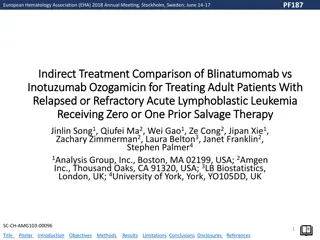Overview of Chronic Leukemia and Myeloproliferative Neoplasms
This comprehensive guide covers the general features, diagnostic approach, and clinicopathological variances between acute myeloid leukemia (AML) and chronic myeloid leukemia (CML), along with insights into myelodysplastic syndrome (MDS) and chronic myelomonocytic leukemia (CMML). It emphasizes the importance of genetic studies in CML diagnosis and treatment, presenting key distinctions and classifications within myeloid neoplasms. Various types of leukemia, including acute and chronic forms, are discussed, shedding light on the unique characteristics and progression of chronic leukemias.
Download Presentation

Please find below an Image/Link to download the presentation.
The content on the website is provided AS IS for your information and personal use only. It may not be sold, licensed, or shared on other websites without obtaining consent from the author.If you encounter any issues during the download, it is possible that the publisher has removed the file from their server.
You are allowed to download the files provided on this website for personal or commercial use, subject to the condition that they are used lawfully. All files are the property of their respective owners.
The content on the website is provided AS IS for your information and personal use only. It may not be sold, licensed, or shared on other websites without obtaining consent from the author.
E N D
Presentation Transcript
Chronic Leukemia Objectives: To understand the general features of Myeloproliferative neoplasms To understand the clinicopathologicaldifferences between acute myeloid leukemia (AML) and chronic myeloid leukemia (CML) To understand the diagnostic approach for chronic leukemia and the major differential diagnosis of CML To recognize the importance of genetic study in diagnosis and treatment of CML. To understand the general aspect of myelodysplastic syndrome (MDS) including definition, pathogenesis, clinical features and prognosis To understand the general aspect of chronic myelomonocyticleukemia (CMML) including definition, pathogenesis, clinical features and prognosis. Color code: Important. Extra. Doctor s Notes References: 436 girls & boys slides 435 teamwork slides Editing file Do you have any suggestions? Please contact us! @haematology436 E-mail: Haematology436@gmail.com or simply use this form
HEMATOLOGY TEAM 436 Chronic leukemias Heterogeneous group of hematopoietic neoplasms Uncontrolled proliferation and decreased apoptotic activity with variable degrees of differentiation this the main difference between MPN and MDS where MDS there is proliferation but apoptosis is enhanced Composed of relatively mature cells the retain the ability to differentiate unlike AML Indolent (progress slowly)(If untreated, the course is in months or years, patient might be asymptomatic for years) Occurs mainly in adults When we have more than 20% blasts it is acute leukemia, and when there is less than 20% it is chronic leukemia Acute leukemia Chronic leukemiaor lymphoma The cells affected or the disease manifestation is in this stage -Main Types of Leukemia:- Acute Chronic Lymphoid ALL LPN(CLL) MPN/MDS (CML) Myeloid AML Acute Mixed Biphenotypic Acute Non 2 Undifferentiated
HEMATOLOGY TEAM 436 -Before we start you have to know the classification of Myeloid Neoplasm According to WHO :- Myeloid Neoplasm Main divisions Myeloproliferative neoplasms (MPN) Myelodysplastic syndromes (MDS) acute myeloid leukemia (AML) MDS/MPN Sub divisions chronic myeloid leukemia (CML) Chronic myelomonocytic leukaemia(CMML) -Myeloproliferative Neoplasms (MPN):- Malignant proliferation of myeloid cells (maturing cells) in blood and bone marrow. Occur mainly in adults Slow onset and long course (may be silent) MPN features:- important! Cytoses increase in the number of cells (may be more than one lineage) Organomegaly (mainly splenomegaly) due to accumulation of the cells and the extra hematopoietic role of the spleen High uric acid the cells are defective and destroyed forming the uric acid from the purines of DNA Hypercellularbone marrow the bone marrow is about 50% cellular but in case of MPN proliferation ( malignancy) increases and could lead to fibrosis Progression to acute leukemia ( mainly AML) the parameter is blast count if above 20% it is considered as acute -Chronic Myeloid Leukemia (CML): Stem cell MPN. Predominant proliferation of granulocytic cells. Consistently associated with the BCR-ABL1 fusion gene (Most important feature of CML) located in the Philadelphia (Ph) chromosome (abnormal chromosome) which results from t(9;22) The main types of cells that found in CML are: Myelocyte& Neutrophils 3
HEMATOLOGY TEAM 436 These are normally present in the blood but if we find any of the precursors it is abnormal. How do they enter the blood? The bone marrow becomes hypercellular and the cells become crowded and start leaving and enter the blood. -Pathogenesis of Chronic myeloid leukemia: It acts like ON/OFF Button in many processes and proliferation is one of them Translocation of the ABL segment on chromosome 9 to BCR locus on chromosome 22 fusing together in the chromosome the result is named Philadelphia chromosome 22 chromosome This fusion gene has a binding site for ATP(the activity of Imatinib treatment is binding to this site and blocking it) that initiate the process of phosphorylation-activation-by tyrosine kinase of a substrate like JAK-2 involved in the transduction pathway that give rise to a state of uncontrolled proliferation . -Clinical Presentation: Asymptomatic presentation (20-40%) Routine CBC : marked leukocytosis Common symptoms : Fatigue ,weight loss or night sweating Abdominal discomfort due to splenomegaly Splenomegaly (Massive) Splenomegaly 4 !! Very important finding!
HEMATOLOGY TEAM 436 -Main Differential Diagnosis: ) ( :- 1.Chronic myelomonocytic leukemia (CMML) (monocytosis ,BCR-ABL ve). 2.Leukemoid reaction: Leukocytosis due to physiological response to stress or infection. CML Leukaemoid Age Adult Any age WBC count High High but <100,000 Mainly myelocytes and segmented and neutrophils. Differential Mainly Bands Morphology Hypogranular Toxic + Splenomegaly -/+ (massive) NAP score Low High +ve CML BCR/ABL -ve Onset Chronic Acute - Neutrophil Alkaline Phosphatase (NAP)score: Cytochemical stain that estimate the amount of alkaline phosphatase enzyme in neutrophils. CML dysfunction cell do not have alkaline phosphate . But leukmoid is function cell . CML= Low Leukemoid = High 5
HEMATOLOGY TEAM 436 - Chronic Myeloid Leukemia Phases:- Leukocytosis(12-1000 10 /L). Mainly neutrophils and myelocytes. Blasts 10% ,Basophils 20% Stable course (years) Chronic phase Increasing counts 10-19% blasts (basophils 20%) (Why 19% ? because if it is 20 it will be AML) Unstable course (months) Accelerated phase ( 20% blasts = AcuteLeukemia) (80% AML & 20% ALL) Coarse (Weeks) Blastic phase (AML or ALL) - Treatment: 1st line targetedtherapy (tyrosine kinase inhibitors like Imatinib) -Excellent response (5 years survival 90%) 2nd line therapy If no response : stem celltransplantation. This drug bind to ATP site of BCR-ABL competing with tyrosine kinase stopping its action 10 10 100 : ( )Bone Marrow( ) . (Peripheral blood) CML MDS (Apoptosis) (Peripheral blood) )Bone Marrow( 6
HEMATOLOGY TEAM 436 - Myelodysplastic syndromes (MDS):- Group of myeloid neoplasm's characterizedby: 1- Peripheral cytopenia (low Hemoglobin low WBC & lowPLT). 2- Dysplasia (abnormal morphology). 3 Ineffective hematopoiesis (hypercellular bone marrow) 4 Progression to AML (preleukaemic disease). 5 Enhanced apoptosis. in the peripheralblood cause cytopenia Dysplastic Normal No Granules! and number of lobes BM: Hypercellular with dysplasia Blood: Pancytopenia with dysplasia. proliferation - apoptosis = Ineffective hematopoiesis - MDS subtypes classified according to:- 1- Blast count. prognosis depends on the number of blast the higher blast count prognosis is worse. 2- Degree of dysplasia. 3- Genetics: Variable genetic abnormalities mainly -5q (good prognosis more in female) , -7q (bad prognosismore in male) -Treatment: supportive +/- chemotherapy - Chronic Myelomonocytic Leukemia (CMML) - Clonal Hematopoietic malignancy characterized by proliferation of both monocytes and neutrophils it is classified as MDS/MPN disease. MDS/MPN disease: has both (takes features from both) :- -Features of MDS (dysplasia & enhancedapoptosis). -Features of MPN ( marked proliferation). Philadelphia chromosome must benegative. Blast must be less than 20%, Aggressive course (survival rate around 2.5y) Treatment: Chemotherapy SCT (if it is +ve then it is CML) (more than 20% acute) 7
HEMATOLOGY TEAM 436 Effective proliferation Ineffective proliferation - Difference between Chronic Myeloid Leukemia & Acute Myeloid Leukemia CML AML Indolent course . Symptoms appear after a long period onset Rapid Three phases 1.Chronic phase 2.Accelerated phase 3.Blastic phase phases No known phases Gene mutation known as Philadelphia gene T(9;22) Many mutations e.g. t(15;17) etiology Marked ( sometimes severe or massive especially spleen) hepatosplenomegaly moderate Blasts Fewer than 20% > 20% Cell count Cytosis Cytopenia 8
HEMATOLOGY TEAM 436 MCQs: 1. The mutation responsible for the effects and manifestations of CML is : A. t(15;17) B. Philadelphia chromosome C. Chromosome 5 monosomy D. Chromosome 7 monosomy 2. The distinguishing feature of AML is: A. Blast > 20% B. Cytosis C. bone marrow failure D. Hepatomegaly 3. A 55 year old patient came to the clinic for a regular check up. He does not complain of any symptoms. His results are as follows: High WBC count, Mainly bands, High NAP score. What is the most likely diagnoses: A. CML B. AML C. CMML D. infection 4. CMML is presented with cytopenia and decreased apoptosis: A. True B. False 5. Which one of the following genes Must be positive in CML? A. APC B. BCR-ABL C. REKA-B D. P53 Answers: 1. B , 2. A , 3. D , 4. B, 5. B Good Luck ! Team members: Abdullah Al-Twerki Ziad Al-Anazi Team Leaders Abdulaziz Al-Hussainy Safa Al-Osaimi 9
